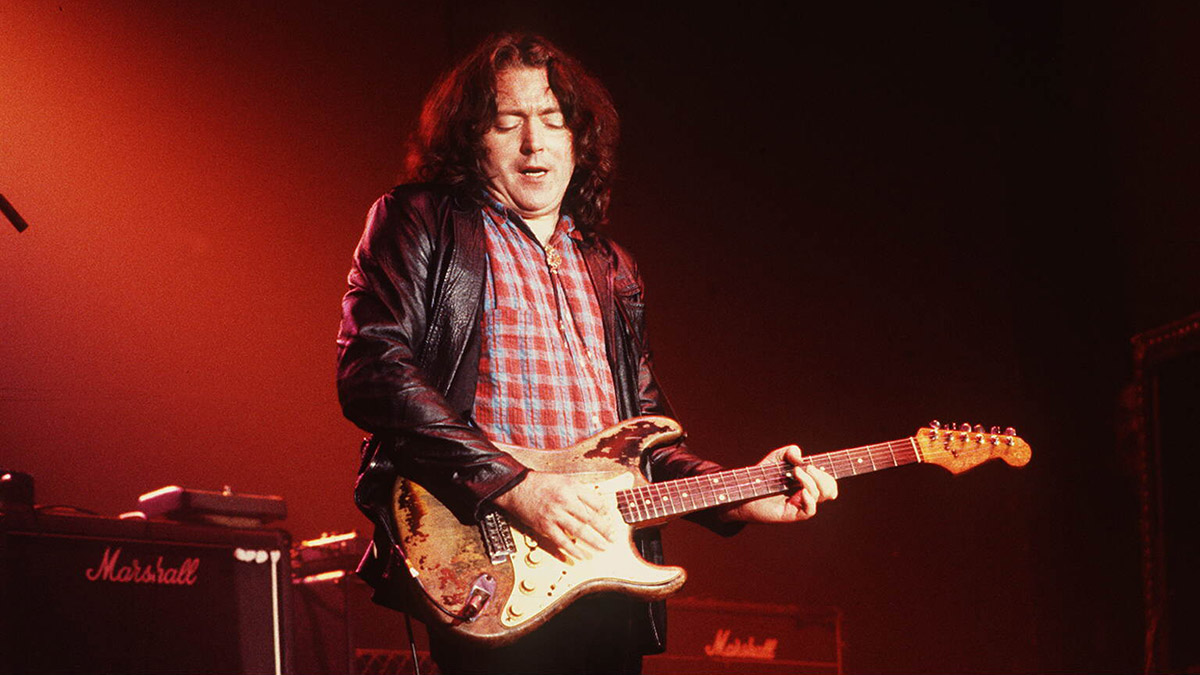Learn Rory Gallagher’s soloing techniques
These two in-depth solos take a whistle-stop tour of the Irish guitar hero's signature style

This month we take a look at an unsung member of the late '60s guitar god hierarchy and one of Ireland’s first rock stars, Rory Gallagher. Despite his immense talent, prolific recording output and extensive touring, Gallagher never really achieved the fame or the guitar star status he so deserved.
Throughout his career he was determined in his rejection of compromise for commercialism’s sake, refusing to allow the release of singles to attract a wider mainstream audience that might well have brought him worldwide success.
Regardless of this shunning of the mainstream, Gallagher earned a solid fanbase that has grown considerably in the years after his untimely death in 1995, aged just 47. Audiences around the world are still captivated by his primitive passion, his unwavering devotion to his roots-based sound, and to his mesmerising performances.
The body of work he has left behind is remarkable for its consistency, honesty and earthiness, and his influence can be recognised in the generations of guitarists that followed.
Gallagher was a traditionalist at heart. He had studied the masters with great attention to detail and commanded an authenticity that can only be earned from a deep devotion to the music. However, his unique style came from a melting pot of influences, perhaps most interesting being the inclusion of the traditional Irish folk that he grew up listening to.
If there was ever a contender for the king of Celtic blues, then Gallagher would surely be chief amongst them. He mixed these two styles along with elements of rock, country, jazz and everything else he could absorb. This gave him a unique approach to improvising, which was often based around full seven note scales compared to the more traditional pentatonic palette we might expect.
He would include 2nds and 6ths and often created lines that weaved slurred patterns of notes along a single string, perhaps because he was also an accomplished slide player.
His playing was raw and ferocious, and his performances unmatched in their intensity. Gallagher's passion was visible for all to see as he put his heart and soul into every second of his performances, delivering solos littered with pinch harmonics and a powerful vibrato.
At other times he was capable of real subtlety and tenderness, using volume swells to coax violin-esque sounds from his battered Fender Stratocaster. No one-trick pony, his sets would also include acoustic numbers, touching on the country blues and folk influences that often saw Gallagher sing with intent and passion (a side to his talent that’s so often overlooked).
All in all, Gallagher was a master. His unwavering commitment to his craft and his virtuosic command of six strings have earned him legendary status, and it’s not difficult to see why.
Get the tone
Amp settings: Gain 4, Bass 3, Middle 6, Treble 6, Reverb 3
Gallagher played his beaten-up 1961 Strat almost exclusively. He was a fan of Vox AC30s as well as numerous Fender amps, often using a treble booster to push the amp a little harder. To get close to his sound, aim for an ‘edge of breakup’ tone with plenty of mids and treble, keeping the bass quite low. A little reverb will add some depth to the tone.
Example 1.
This first example shows how Gallagher might approach a 12-bar blues, with a more linear scale based lines than you might expect in this generally more pentatonic-based genre, this time leaning heavily on the Dorian sound.
We also see his extensive use of hammer-on, pull-off and slide combinations that he was fond of. Aim to get close to Gallagher's intensity here by employing a strong vibrato and digging in hard with the guitar pick.
Example 2.
Study two is based on more of a blues-rock style, this time featuring a shuffle groove. This gives us the opportunity to develop our triplet feel which, when combined with Gallagher's scale-based approach, gives us some of the Celtic flavour that was a big part of his sound (we hear a little of this in Gary Moore’s playing but not to the extent that we do in Gallagher’s). We also see pull-offs to open strings and volume swells, two concepts often used by Gallagher.
Get The Pick Newsletter
All the latest guitar news, interviews, lessons, reviews, deals and more, direct to your inbox!
David is a guitarist, producer, and educator. He has performed worldwide as a session musician, with artists and bands spanning many musical genres. He draws upon over 20 years of experience in both live performance and studio work, as well as numerous composing credits. As a producer, he's collaborated with artists across genres, including pop, RnB, and neo soul. David holds a master’s in jazz guitar and teaches at BIMM London and the London College of Music. He is also a regular contributor to Guitar Techniques magazine, sharing his love of blues in a monthly column.









![Joe Bonamassa [left] wears a deep blue suit and polka-dotted shirt and plays his green refin Strat; the late Irish blues legend Rory Gallagher [right] screams and inflicts some punishment on his heavily worn number one Stratocaster.](https://cdn.mos.cms.futurecdn.net/cw28h7UBcTVfTLs7p7eiLe.jpg)


